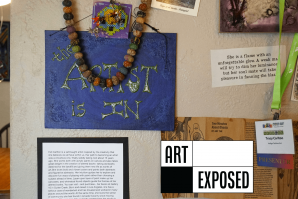Driving among the idyllic rolling hills, storied wine country and charming Gold Rush-era towns of Amador County, you might think you’ve stepped back into the past. But one organization in this small rural county is looking to the future — and working to build a sustainable creative economy to meet it.
Amador Arts, the official Amador County arts council and state-local partner, is an organization with small-town roots and big dreams. The nonprofit arts organization started as a grassroots effort by community members in 1978 and has raked in hundreds of thousands of grant dollars in recent years, with Executive Director Meghan Joy O’Keefe at the helm.
O’Keefe has spearheaded fundraising efforts (alongside the board of directors) since they were hired as executive director in 2018. O’Keefe had already been working with the organization as music coordinator and program coordinator, organizing a Friday night concert series and collaborating on other creative projects prior to the promotion, but their history with Amador Arts goes back much farther. Now 44, they were just 10 years old and in fifth grade at Sutter Creek Elementary when they were taught their first art lesson by Amador Arts teaching artist Bruce Peccianti, who helped create an arts curriculum for the nonprofit and still teaches today.
O’Keefe also received a scholarship from Amador Arts in 1997 as a senior graduating from Amador High School, and those funds were key to O’Keefe’s ability to pursue a career in the performing arts. O’Keefe purchased an electric piano with the funds, which then traveled around the country with the budding actor and singer.
“If I hadn’t had that scholarship from Amador County Arts Council, maybe those things wouldn’t have happened,” says O’Keefe, whose job now is to help other local youth pursue their dream career in the arts.
Cilladean Hopkins is one of those youths. The 22-year-old Amador County local (now living in Humboldt County) is a performance artist and owner of craft jewelry business Queer Tears Creations. Hopkins served as a student director at Amador Arts while in high school from 2016 to 2019 and now works remotely for the arts council as outreach coordinator, writing press releases and monthly newsletters.
In 2019, Hopkins received a scholarship from the arts council which helped pay their way into Dell’Arte International School of Physical Theatre, a one-year certificate program in the art of clowning and theater.
“I will forever be grateful to Amador Arts,” says Hopkins. “Even when I didn’t believe in myself and my art, I always had the support of the arts council.”
Along with scholarships, the arts council serves as an avenue for real-world arts administration experience for youth in Amador, where few other opportunities exist.
“I learned about the importance and hard work of arts administration and advocacy. My time serving opened me up to so many different opportunities including arts education advocacy work, organizing, volunteer service and event hosting,” says Hopkins.
The arts council started in 1978 with a grassroots community
effort and has been housed in various locations, including the
Sutter Creek Grammar School building which the organization’s
home office returned to this September.

Sidney Cohen served as student director in 2017 and 2018, and then joined the board of directors and served as secretary following graduation. Now a professional carpenter building theater sets for the Oregon Shakespeare Festival, Cohen regards his time on the board as one of learning “a lot about life,” including the inner workings of nonprofit management and governance.
“I think that doing that work with the nonprofit made me think, ‘Oh, there’s a path that I can have a career in the arts,’ because it is not always very obvious,” says Cohen.
Cohen learned about Amador Arts through O’Keefe, who taught musical theater workshops to Amador High School drama classes and became a mentor and friend to Cohen. O’Keefe, then employed by the arts council but not yet executive director, invited Cohen to consider joining the board at a time when there was a large turnover; long-standing board members were giving up their seats and Amador Arts was in the process of a makeover.
“I was there through a really, really tumultuous shift in the organization. There’s a lot of people who had been there for a long time leaving, and I like to think that the program is in a better place now than it was. … I think they’re really trying to create programs (where) the focus is helping people and creating,” says Cohen.
By the time O’Keefe became executive director, a Sutter Creek art gallery run by the nonprofit came and went, arts education programming expanded from one project for fourth graders in the county, to one art class for every elementary-grade class in the county, and in 2018, the same year O’Keefe was hired, the Amador County Board of Supervisors added $5,000 to the county budget to support Amador Arts programming.
While the arts council historically relied heavily on private donations and fundraising events, it was the work of a few employees, like O’Keefe and her predecessor Terra Forgette, who brought big bucks to the budget through grant applications.
“We’ve worked really hard to grow our revenue mostly by writing and obtaining more grant funding, so our revenue has grown by over 300 percent since I was hired in 2017,” explains O’Keefe.
Former Amador Arts board member DeDe Ryan says “Meghan has done an amazing job at bringing in a lot of money for the county for a really small rural county.” In 2010, when Ryan was elected board president, the shoestring budget of $25,000 wasn’t enough to afford staff.
Today, Amador arts has nine paid employees, the bulk of whom are teaching artists whose contracts are paid through donations, not grants.Those teaching artists make up one of the arts council’s fundamental programs, arts education.
Since arts education is not funded by the county, the arts council teamed up with the Amador County Unified School District and the Amador County Office of Education to offer an arts education plan that meets state requirements by bringing arts education to every classroom (including special education) in each of the county’s elementary schools through contracted local artists.
Along with arts education, the council has programs on advocacy which include tobacco use prevention, suicide awareness and prevention, mental health. It also hosts multicultural events such as art shows that celebrate Black and local Indigenous history, and a Mesoamerican dance group. Joining forces with Create CA’s Arts Now initiative, Amador youth will also have the chance to participate in a new advocacy-based leadership program just for young adults.
The arts council’s focus on advocacy and inclusivity may seem particularly modern to its rural population of around 41,000 people, but to O’Keefe, it’s simply part of the job.
“It is the work, the task of an arts council, not to engage in art for art’s sake. It is to advance the creative sector for all of these way grander reasons,” explains O’Keefe. “Art for art’s sake just ends up happening kind of as a side bonus, but our job is to serve all people and make sure we’re serving historically underserved people and to elevate the creative economy because the arts are so essential to a thriving economy.”
It’s also a requirement of any state-local partner. “The state is also really clear about how our job is to promote that whole creative sector, and that’s really nice that they’re clear about that because what we all know is, it’s not political. It is about all people engaging in arts and cultural expression, all people,” O’Keefe says. “And so what that really is is intercultural exchange and a tradition of being intercultural in our communities so that we really want to be at the forefront of driving home this message that wherever you go in California, whatever county you’re in, there is intercultural exchange where people from all different kinds of backgrounds are enjoying time and space together, where we celebrate all different ways of life.
Engaging youth and young adults is a priority for O’Keefe, who
says that teens and young adults have the least number of
services in the county, with no local secondary education option
and limited public transportation.

“A thriving economy serves everybody, and that means we celebrate all the cultures,” they add.
Last fiscal year, Amador Arts received over $260,000 in grant funding, including a Creative Youth Development grant from the California Arts Council, which is funding a new music and movement program for children the age of 5. Amador youth in junior high will also soon have the opportunity to take field trips to the Crocker Art Museum through another new program.
Grant dollars also help hire young staff members like Hopkins, Administrative Coordinator Deja Douglas and Administrative Assistant Lee Thibodeaux, who work part time at Amador Arts’ new office inside the historic Sutter Creek Grammar School building. Douglas, who was the county’s second poet laureate (another Amador Arts program) in 2020, handles website updates and social media and mentors the student director program, while Thibodeaux creates digital graphics and will be heading up the student advocacy program and a brand new TikTok account for Amador Arts.
A student intern, Madison Shearer, also creates animation for Amador Arts through the WorkAbility program.
Engaging youth and young adults is a priority for O’Keefe, who says that teens and young adults have the least number of services in the county, with no local secondary education option and limited public transportation. “Those are the future leaders of Amador County,” says O’Keefe.
Along with student scholarships, the arts council administers grants to artists and arts organizations, a program that O’Keefe says the arts council hopes to grow by 1,000 percent in the next five years. Some of these grant opportunities are directed at specific marginalized rural communities, like rural LGBTQIA, youth, Black and Indigenous community members.
O’Keefe also helps local artists apply for external grants. So far, the grant application assistance has brought almost $200,000 to Amador County artists.
“I think it might be one of the most fun things that I do in my job because it’s so inspiring to listen. An artist, many of whom don’t really believe in themselves as much as they should, comes in with a brilliant idea, and they’re all brilliant and then wants like heck to get this money and to listen to them tell their story, and then help them distill it down into not enough words, but somehow make those words compelling enough to catch the eyes of a panelist. That’s a really satisfying challenge,” says O’Keefe.
Recommended For You

Book Review: ‘Artists Remaking Medicine’
Health care professionals and artists learn from each other in a new anthology
Just released in September of 2023, this anthology on the intersection of art and medicine offers a poignant look at the history, practice and future of radical creativity in the industry.

Art Exposed: Tracy ‘Indi’ Carlton
Meet the Amador County artist who traded in a 21-year nonprofit career to become a creative expression coach
Tracy Carlton took an unconventional path to her art career, launching a as a creative expression coach and teacher last year following a 21-year career at First 5 Amador, the Amador County branch of the statewide nonprofit commission dedicated to improving early childhood development.

Art Exposed: Carrie Hennessey
The vocalist, instructor and writer emphasizes positive energy and risk-taking, whether onstage or coaching others
Carrie Hennessey has been known to belt out a tune while walking her dogs outside of her South Natomas home, but the neighbors in this otherwise quiet neighborhood don’t seem to mind. She picked up the moniker “Opera Mom” while her two children (now in their 20s) were in elementary school, but there is a lot more to her.

Art Exposed: Betty Nelsen
On the art of how to look in the mirror
In revisiting her early self-portraits, Betty Nelsen has zeroed in on the strongest elements, cropping the drawings into pages that will go into a series of handmade books.

Art Exposed: Beti Masenqo
The musician-singer-songwriter blends folk and rock with the Ethiopian songs of her childhood
When she performs, singer and songwriter Beti Masenqo leaves this earthly plane in a way that seems entirely effortless.



